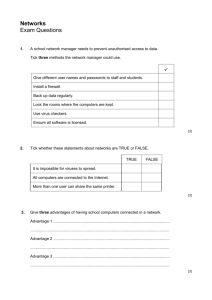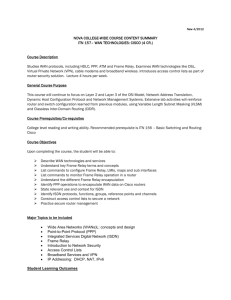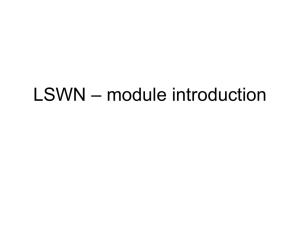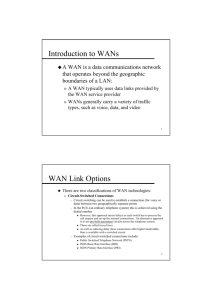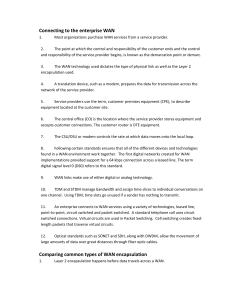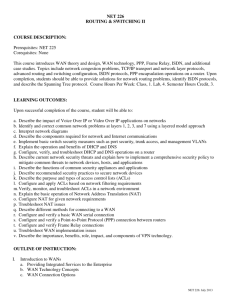Lesson 7 Presentation
advertisement
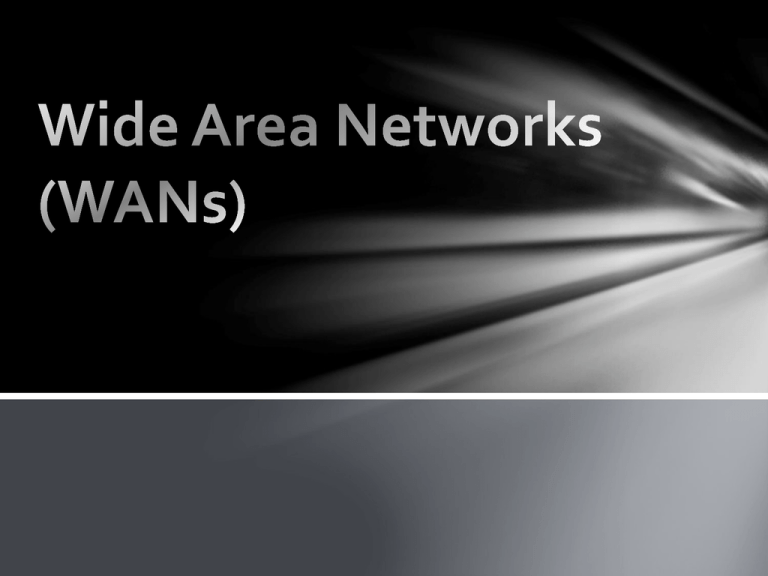
What is a WAN? A wide area network (WAN) is a computer network that covers a broad area (i.e., any network whose communications links cross metropolitan, regional, or national boundaries). This is in contrast with personal area networks (PANs), local area networks (LANs), campus area networks (CANs), or metropolitan area networks (MANs) which are usually limited to a room, building, campus or specific metropolitan area (e.g., a city) respectively. WANs are used to connect LANs and other types of networks together, so that users and computers in one location can communicate with users and computers in other locations. Many WANs are built for one particular organization and are private. Others, built by Internet service providers, provide connections from an organization's LAN to the Internet. WANs are often built using leased lines. At each end of the leased line, a router connects to the LAN on one side and a hub within the WAN on the other. Leased lines can be very expensive. Instead of using leased lines, WANs can also be built using less costly circuit switching or packet switching methods. Network protocols including TCP/IP deliver transport and addressing functions. Protocols including Packet over SONET/SDH, MPLS, ATM and Frame relay are often used by service providers to deliver the links that are used in WANs. X.25 was an important early WAN protocol, and is often considered to be the "grandfather" of Frame Relay as many of the underlying protocols and functions of X.25 are still in use today (with upgrades) by Frame Relay. WAN Example WAN Services Option: Leased line Description Advantages Point-to-Point connection between two computers or Local Most secure Area Networks (LANs) Circuit switching A dedicated circuit path is created between end points. Best example is dialup connections Packet switching Devices transport packets via a shared single point-to-point or point-to-multipoint link across a carrier internetwork. Variable length packets are transmitted over Permanent Virtual Circuits (PVC) or Switched Virtual Circuits (SVC) Cell relay Similar to packet switching, but uses fixed length cells instead of variable length packets. Data is divided into fixed-length cells and then transported across virtual circuits Disadvantages Bandwidth range PPP, HDLC, SDLC,HN AS Expensive Less Expensive Call Setup Shared media across link Best for simultaneous Overhead can be use of voice and considerable data Sample protocols used 28 - 144 kbps PPP, ISDN X.25 Frame-Relay ATM WAN Virtual Circuits A virtual circuit is a logical circuit created within a shared network between two network devices. Two types of virtual circuits exist: switched virtual circuits (SVCs) and permanent virtual circuits (PVCs). SVCs are virtual circuits that are dynamically established on demand and terminated when transmission is complete. Communication over an SVC consists of three phases: circuit establishment, data transfer, and circuit termination. The establishment phase involves creating the virtual circuit between the source and destination devices. Data transfer involves transmitting data between the devices over the virtual circuit, and the circuit termination phase involves tearing down the virtual circuit between the source and destination devices. SVCs are used in situations in which data transmission between devices is sporadic, largely because SVCs increase bandwidth used due to the circuit establishment and termination phases, but they decrease the cost associated with constant virtual circuit availability. PVC is a permanently established virtual circuit that consists of one mode: data transfer. PVCs are used in situations in which data transfer between devices is constant. PVCs decrease the bandwidth use associated with the establishment and termination of virtual circuits, but they increase costs due to constant virtual circuit availability. PVCs are generally configured by the service provider when an order is placed for service. WAN Devices WANs use numerous types of devices that are specific to WAN environments. WAN switches, access servers, modems, CSU/DSUs, and ISDN terminal adapters are discussed in the following sections. Other devices found in WAN environments that are used in WAN implementations include routers, ATM switches, and multiplexers. The following slides discuss some WAN devices. WAN Switch A WAN switch is a multiport internetworking device used in carrier networks. These devices typically switch such traffic as Frame Relay, X.25, and SMDS, and operate at the data link layer of the OSI reference model. The image below shows two routers at remote ends of a WAN that are connected by WAN switches. Access Server An access server acts as a concentration point for dial-in and dial-out connections. The image below illustrates an access server concentrating dial-out connections into a WAN. Modem A modem is a device that interprets digital and analogue signals, enabling data to be transmitted over voice-grade telephone lines. At the source, digital signals are converted to a form suitable for transmission over analogue communication facilities. At the destination, these analogue signals are returned to their digital form. The image below illustrates a simple modem-to-modem connection through a WAN. CSU/DSU A channel service unit/digital service unit (CSU/DSU) is a digital-interface device used to connect a router to a digital circuit like a T1. The CSU/DSU also provides signal timing for communication between these devices. The image below illustrates the placement of the CSU/DSU in a WAN implementation. ISDN Terminal Adapter An ISDN terminal adapter is a device used to connect ISDN Basic Rate Interface (BRI) connections to other interfaces, such as EIA/TIA-232 on a router. A terminal adapter is essentially an ISDN modem, although it is called a terminal adapter because it does not actually convert analog to digital signals. The image below shows the placement of the terminal adapter in an ISDN environment. WAN and the OSI Model WAN technologies are considered to exist and function at the three lower layers of the OSI model – Physical, Data Link, and Network. While not all WAN technologies have elements that function at the Network Layer, some (like X.25 and ISDN) do. The figure below provides an overview of how the WAN technologies that you’ll look at in this chapter map to the OSI model. WAN Encapsulation Formats HDLC - HDLC stands for High-Level Data Link Control protocol. Like the two other WAN protocols mentioned in this article, HDLC is a Layer 2 protocol. HDLC is a simple protocol used to connect point to point serial devices. For example, you have point to point leased line connecting two locations, in two different cities. HDLC would be the protocol with the least amount of configuration required to connect these two locations. HDLC would be running over the WAN, between the two locations. Each router would be deencapsulating HDLC and turning dropping it off on the LAN. HDLC performs error correction, just like Ethernet. Cisco’s version of HDLC is actually proprietary because they added a protocol type field. Thus, Cisco HDLC can only work with other Cisco devices. HDLC is actually the default protocol on all Cisco serial interfaces. If you do a show running-config on a Cisco router, your serial interfaces (by default) won’t have any encapsulation. This is because they are configured to the default of HDLC. If you do a show interface serial 0/0, you’ll see that you are running HDLC. WAN Encapsulation Formats Cont. PPP - You may have heard of the Point to Point Protocol (PPP) because it is used for most every dial up connection to the Internet. PPP is documented in RFC 1661. PPP is based on HDLC and is very similar. Both work well to connect point to point leased lines. • The differences between PPP and HDLC are: • PPP is not proprietary when used on a Cisco router • PPP has several sub-protocols that make it function. • PPP is feature-rich with dial up networking features Because PPP has so many dial-up networking features, it has become the most popular dial up networking protocol in use today. Here are some of the dial-up networking features it offers: • Link quality management monitors the quality of the dial-up link and how many errors have been taken. It can bring the link down if the link is receiving too many errors. • Multilink can bring up multiple PPP dialup links and bond them together to function as one. • Authentication is supported with PAP and CHAP. These protocols take your username and password to ensure that you are allowed access to the network you are dialing in to. WAN Encapsulation Formats Cont. Frame Relay - Frame Relay is a Layer 2 protocol and commonly known as a service from carriers. For example, people will say “I ordered a frame-relay circuit”. Frame relay creates a private network through a carrier’s network. This is done with permanent virtual circuits (PVC). A PVC is a connection from one site, to another site, through the carrier’s network. This is really just a configuration entry that a carrier makes on their frame relay switches. Obtaining a frame-relay circuit is done by ordering a T1 or fractional T1 from the carrier. On top of that, you order a frame-relay port, matching the size of the circuit you ordered. Finally, you order a PVC that connects your frame relay port to another of your ports inside the network. Frame Relay Cont. The benefits to frame-relay are: • Ability to have a single circuit that connects to the “frame relay cloud” and gain access to all other sites (as long as you have PVCs). As the number of locations grow, you would save more and more money because you don’t need as many circuits as you would if you were trying to fully-mesh your network with point to point leased lines. • Improved disaster recovery because all you have to do is to order a single circuit to the cloud and PVC’s to gain access to all remote sites. • By using the PVCs, you can design your WAN however you want. Meaning, you define what sites have direct connections to other sites and you only pay the small monthly PVC fee for each connection. Some other terms you should know, concerning frame relay are: LMI = local management interface. LMI is the management protocol of frame relay. LMI is sent between the frame relay switches and routers to communicate what DLCI’s are available and if there is congestion in the network. DLCI = data link connection identifier. This is a number used to identify each PVC in the frame relay network. CIR = committed information rate. This is the amount bandwidth you pay to guarantee you will receive, on each PVC. Generally you have much less CIR than you have port speed. You can, of course, burst above your CIR to your port speed but that traffic is marked DE. DE = discard eligible. Traffic marked DE (that was above your CIR) CAN be discarded by the frame -relay network if there is congestion. FECN & BECN = forward explicit congestion notification & backward explicit congestion notification. These are bits set inside LMI packets to alert the frame-relay devices that there is congestion in the network. Practical We will attempt to do what we were going to do last lesson - Tonight we will setup Windows Server 2003 with: • DHCP • DNS • Active Directory • Connect two Windows XP machines and make them log into the domain • Setup Terminal Services
